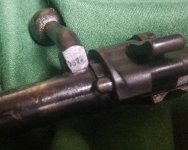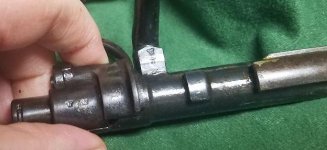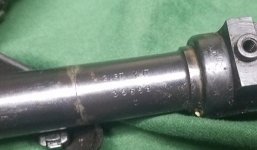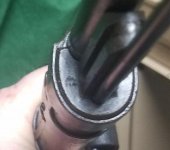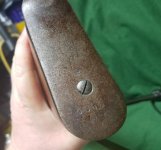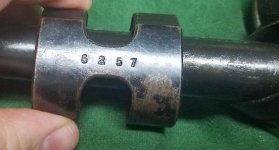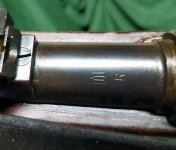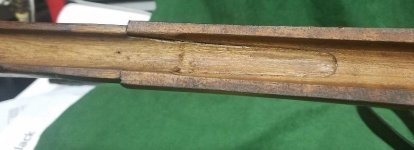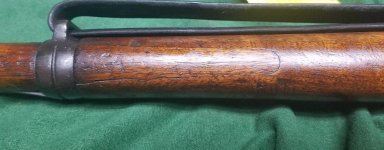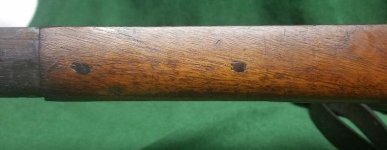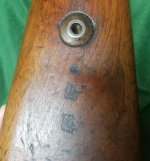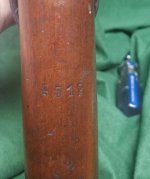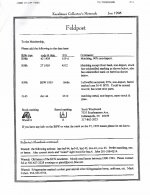I posted this on another forum then found some answer here so I thought I would post it here with more pictures since some of you seem to be tracking these. From my understanding is the mark indicates it was rework at a depot level using a Lithuanian made barrel. This kind of makes since for what I I am seeing on the gun. My guess something happen with a muzzle obstruction or damage to the front. The front band is mismatched but the screws match the front band. All other numbers are matching. The number stamped in the barrel channel dose not match but the external number dose on the stock. The is nothing stamped under the buttplate. The front of the stock has been grafted onto the rear of the stock under the front band, my first thought was a duffel cut but I am not sure now, and the then pinned. The hand guard matches the serial number. The bayonet lug has a mark I am not sure what it is. Its some type of eagle. Any thoughts?

You are using an out of date browser. It may not display this or other websites correctly.
You should upgrade or use an alternative browser.
You should upgrade or use an alternative browser.
Lithuanian marked Nazi 98k
- Thread starter russo-jap
- Start date
An interesting rifle, often these are thoroughly mismatched, - in this case the rifle is already known because in 1998 it was briefly discussed in the KCN (attached), it is good to see actual pictures of the rifle.
Little is really known about the origins, about a decade ago i wrote an article on the subject, I am sure it is quite dated today, but there is next to nothing written about this variation. While Lithuania and her military (& politico-economic) history during this period is well written about, next to nothing is written about the period under German/NS domination. Gaidis wrote the only known books and articles on the subject, some are very comprehensive about the Lithuanian military involvement 1939-1945, - which under the Germans was seriously curtailed, as much from the idiotic occupation policies as lack of enthusiasm on Lithuania's part (some real lost opportunities occurred in the Baltic States). The short of it is that while large stores of Lithuania small arms were recovered by the German in 1941 (the USSR didn't evacuate Lithuania small arms before the German invasion), the Germans didn't seem to use them significantly, - Gaidis writes about the arming of Lithuanian security battalions, who received the bulk of the L24 Belgian made rifles and Browning pistols. This occurred early on, October 1941.
I believe that these German rifles with Lithuanian barrels date to a much later period, 1943-1944, when the Germans formed more "militaristic" formations out of former Lithuanian police and soldiers. So called LAD battalions (security battalions) and TAR battalions (fatherland defense force) plus a few other formations along the same lines. These were regularly armed with German rifles and even in some cases German machine guns, especially the TAR's who were expected to do more front line service. Also heavy machine guns, mortars and anti-tank guns from USSR, Czech, Polish and other occupied countries. Gaidis stated that the intention was to form a special battalion completely with German weapons, but this was not feasible due to allied bombing (100 Lithuanian NCO/Officers even went through German schools for training!). Anyway, these latter formations surely would have access to German ordnance depots, Gaidis states that the units had difficulty getting supplies from German ordnance depots, but suggests that they had the authority to use, probably in some cases succeeded, these depots. Possibly, the Lithuanians had some limited ordnance facilities themselves, re-barrels were typically a ordnance depot level repair, but from my reading the Germans didn't micro-manage these security battalions much. They let them freeze and starve in winter and face heavily armed soviet partisans with limited resources, so it would make sense the Lithuanian commanders probably improvised. Who knows, but the Germans did form police, security (guarding bridges and lines of communication, often outside of Lithuania) and semi-front line battalions with Lithuanian leadership and gave them a wide array of small arms. I am sure they improvised to repair of these weapons that they had limited success accessing German ordnance services.
Can you improve that picture of the wrist, or interpret the character under the eagles, - off hand I seem to recall HZa Königsberg being a possible depot marking on a rifle, which makes sense considering its proximity to Lithuania and the importance of HZa Königsberg (in the Republican era the German ordnance system consisted of three depots, Spandau-Berlin, Cassel/Kassel and Königsberg, though other ordnance shops are known, one particularly at Zeithain (Saxony) where the training ground and schools once existed in Imperial times).
Little is really known about the origins, about a decade ago i wrote an article on the subject, I am sure it is quite dated today, but there is next to nothing written about this variation. While Lithuania and her military (& politico-economic) history during this period is well written about, next to nothing is written about the period under German/NS domination. Gaidis wrote the only known books and articles on the subject, some are very comprehensive about the Lithuanian military involvement 1939-1945, - which under the Germans was seriously curtailed, as much from the idiotic occupation policies as lack of enthusiasm on Lithuania's part (some real lost opportunities occurred in the Baltic States). The short of it is that while large stores of Lithuania small arms were recovered by the German in 1941 (the USSR didn't evacuate Lithuania small arms before the German invasion), the Germans didn't seem to use them significantly, - Gaidis writes about the arming of Lithuanian security battalions, who received the bulk of the L24 Belgian made rifles and Browning pistols. This occurred early on, October 1941.
I believe that these German rifles with Lithuanian barrels date to a much later period, 1943-1944, when the Germans formed more "militaristic" formations out of former Lithuanian police and soldiers. So called LAD battalions (security battalions) and TAR battalions (fatherland defense force) plus a few other formations along the same lines. These were regularly armed with German rifles and even in some cases German machine guns, especially the TAR's who were expected to do more front line service. Also heavy machine guns, mortars and anti-tank guns from USSR, Czech, Polish and other occupied countries. Gaidis stated that the intention was to form a special battalion completely with German weapons, but this was not feasible due to allied bombing (100 Lithuanian NCO/Officers even went through German schools for training!). Anyway, these latter formations surely would have access to German ordnance depots, Gaidis states that the units had difficulty getting supplies from German ordnance depots, but suggests that they had the authority to use, probably in some cases succeeded, these depots. Possibly, the Lithuanians had some limited ordnance facilities themselves, re-barrels were typically a ordnance depot level repair, but from my reading the Germans didn't micro-manage these security battalions much. They let them freeze and starve in winter and face heavily armed soviet partisans with limited resources, so it would make sense the Lithuanian commanders probably improvised. Who knows, but the Germans did form police, security (guarding bridges and lines of communication, often outside of Lithuania) and semi-front line battalions with Lithuanian leadership and gave them a wide array of small arms. I am sure they improvised to repair of these weapons that they had limited success accessing German ordnance services.
Can you improve that picture of the wrist, or interpret the character under the eagles, - off hand I seem to recall HZa Königsberg being a possible depot marking on a rifle, which makes sense considering its proximity to Lithuania and the importance of HZa Königsberg (in the Republican era the German ordnance system consisted of three depots, Spandau-Berlin, Cassel/Kassel and Königsberg, though other ordnance shops are known, one particularly at Zeithain (Saxony) where the training ground and schools once existed in Imperial times).
Attachments
That's great that you have it after 20 years!
The BSW/39 was a build by a LZa, it was never a BSW/39, rather the receiver was diverted to a LW ordnance depot and built up around 1941-42, these are actually pretty common and most are in good shape. Unlike in WWI, the Germans in WWII never had enough rifles, or small arms in general. You saw this sort of thing in WWI, but nothing like what you saw in WWII.
The BSW/39 was a build by a LZa, it was never a BSW/39, rather the receiver was diverted to a LW ordnance depot and built up around 1941-42, these are actually pretty common and most are in good shape. Unlike in WWI, the Germans in WWII never had enough rifles, or small arms in general. You saw this sort of thing in WWI, but nothing like what you saw in WWII.



